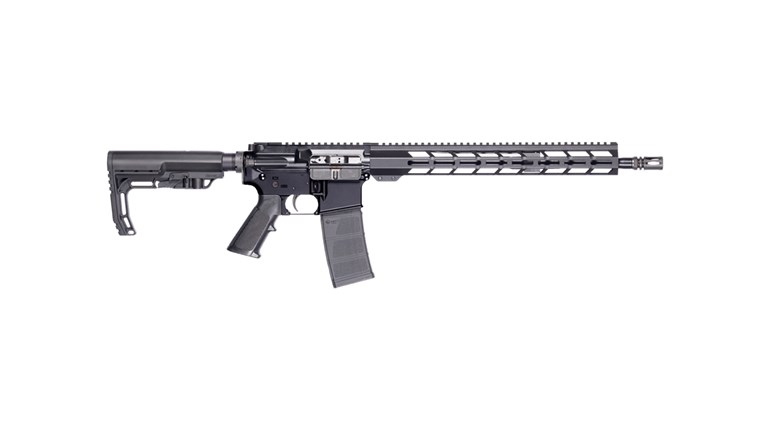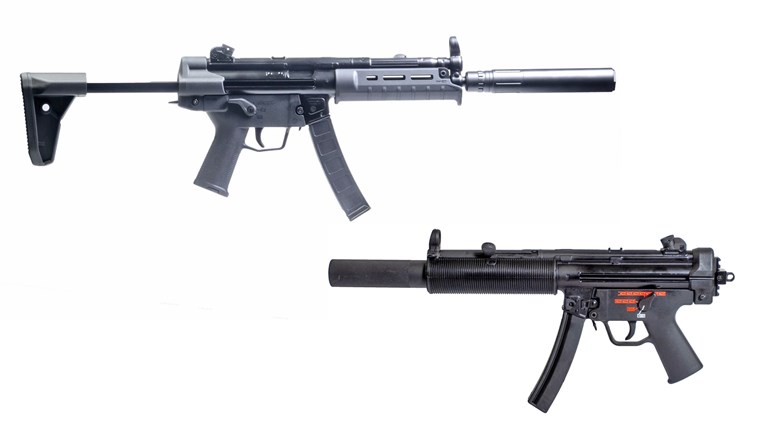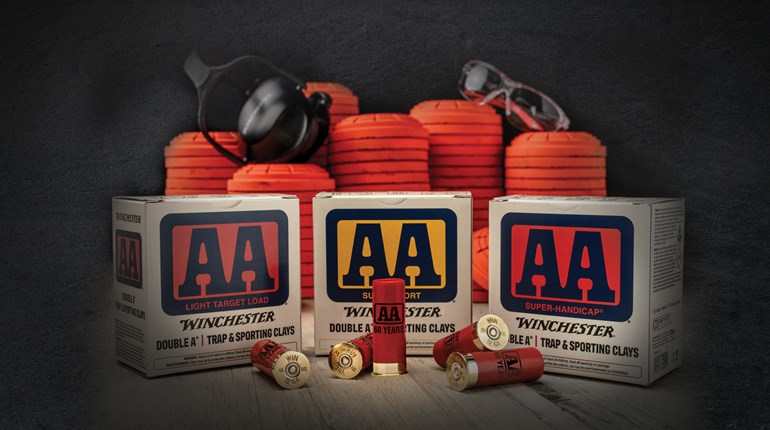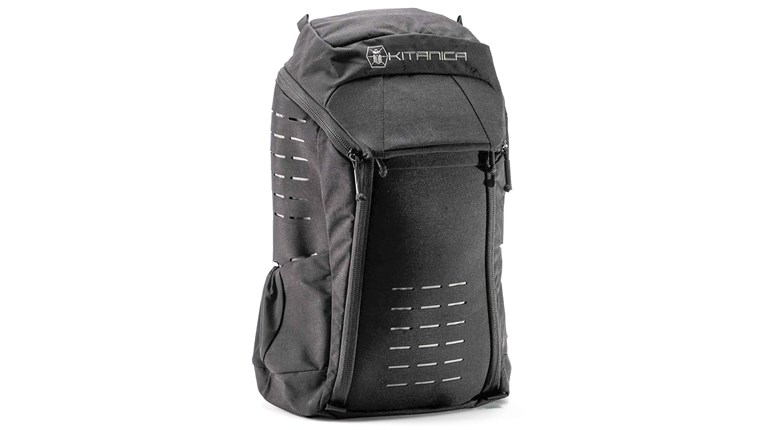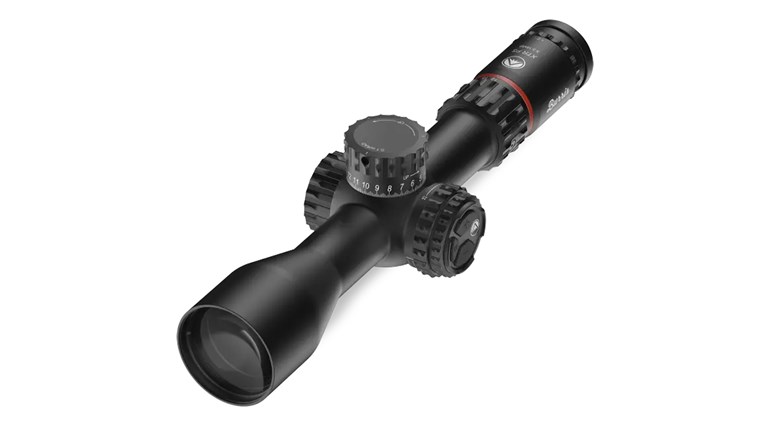
Until the original AR15, the only direct-impingement rifles of note were the French MAS49 and the Swedish AG42, along with its licensed Egyptian clones. While the AR-15 and M16 went on to become spectacularly successful, the unusual gas system wasn't without critics, and numerous piston uppers have come to market. Two of the most interesting are the CMMG Mod4 SA, a short-stroke design, and the Faxon ARAK21 which, true to its name, is an AK-47-like long-stroke gas system in an AR15-like ergonomic package. Both approaches promise—and deliver—cleaner cycling with less powder residue around the bolt and less blowback from the ejection port or charging handle opening.
The CMMG rifle looks very similar to a conventional AR, with only a small gas regulator at the front giving away its nature. Short stroke systems are generally lightweight, with the piston moving only a short distance before striking the bolt carrier. Since the piston is not attached to the bolt carrier and has to be re-set for the next cycle, it usually has an additional return spring wrapped around it. The manual-of-arms is substantially close to the regular AR15, with the added option of regulating the gas flow manually. The feel of the rifle is also similar, with slight recoil and minimal movement off the point of aim. Accuracy was surprisingly good for a lightweight 16-inch carbine with M4-stepped-barrel profile.

The exceptional performance of inexpensive American Eagle 55-grain ball ammunition makes practice affordable. Consistent 1.25-inch grouping with match ammunition using only a 6-power scope makes this carbine an outstanding performer in its category. True to the piston promise, the bolt and carrier remained clean after over 300 rounds fired. Number of malfunctions: zero.
The Faxon ARAK21 is a long-stroke rifle, meaning the piston is a part of the bolt carrier. It has fewer moving parts but more reciprocating mass during each firing cycle. The main advantage, besides the simplicity of construction, is the greater momentum giving higher resistance to feeding and extraction problems. Like the CMMG carbine, ARAK21 has a rotary-gas regulator up front, and that's about the only design similarity between the two. Heavier by about one pound, ARAK21 packs a great number of extra features.
Six screws retaining the handguard come off in seconds, and then the barrel can be swapped for another profile, length or caliber. Currently, 5.56 NATO and 7.62x35 mm (.300 AAC Blackout) barrels can be used with the same bolt, and a 7.62x39 mm barrel can be used with a replacement bolt (but same carrier). Recoil springs are color-coded, and Faxon also offers rubber bands for labeling magazines to avoid mixing up calibers at the range. AR pattern magazines are used for all calibers. If a Unimag is used, 25 rounds of 7.62x39 can be fed from the same magazine as 30 rounds of 5.56 NATO or .300 AAC Blackout. Changing the barrel either requires re-zeroing, or using multiple sights on return-to-zero quick-detach mounts. When calculating hold-overs for long range, keep in mind that the ARAK21 rail sits 0.4-inch above that of a conventional AR15 upper. Most of the extra height comes from the return spring positioned within, which permits the use of folding stocks.

Long-stroke design produces a very different feel during firing. Felt recoil is so light with all three calibers as to be negligible. I've shot .22s that kicked as much. Spread over a longer time, the gradual push-back does pull the gun slightly more off-target in the end than with direct impingement, but the wear on the shooter is much reduced. Number of malfunctions over approximately 500 rounds of 5.56 NATO and 300 rounds of 7.62x39 mm: zero.
The gun runs extremely cleanly even with sound suppressors. With the non-reciprocating charging handle placed on the left or the right of the fore-end—sides can be switched in seconds—the back of the ARAK21 receiver is enclosed, so no blowback gets to the shooter. Of all AR rifles, only the side-charging JP Enterprises LPR07 can match that feat. Variable gas regulator allows tuning for subsonic or high velocity ammunition.
The bolt can be inserted into the carrier two orientations, 180 degrees off from each other. Depending on the location of the plunger-type ejector, empties come out of the left or the right ejection port. The change-over takes only a few seconds and makes the rifle very convenient for sharing between left and right handed shooters.
Accuracy tests yielded good results with heavier weight bullets. PPU Match 75-grain was the winner with 1.75-inch groups, but 55- and 62-grain ball grouped poorly. Faxon technical staff said that was atypical behavior for the 1:8-inch twist barrel and offered to swap it. Thanks to the quick-swap design, that's an easy fix. I found Faxon to be very helpful to me and to other owners of their rifles in diagnosing and solving any issues that come up. It's difficult to comment conclusively on the accuracy of ARAK21 because it differs from barrel to barrel. The 7.62x39 mm barrel produced spreads of 2.25 to 2.5 inches with every ammunition type tried, which is pretty good for that cartridge.
While ARAK21 will fit any AR15 lower, Faxon produces a lower specially mated to match the geometry of the upper. It comes with an excellent trigger. The rifle is capable of much better accuracy than 1.75 inches—I have seen it achieved with heavier barrels by other ARAK21 owners. It also runs very well with the 12.5-inch barrel used for SBRs in the US and for export to countries like Italy which do not have the length restrictions.
In sum, the short-stroke design proves itself as the way to go for short, handy carbines with good accuracy. Long stroke excels for sustained fire when shooter endurance comes into play. The ARAK21, in particular, achieves the system flexibility that was once promised by the Stoner 63, with the ability to mix and match barrel length and calibers, ejection and charging handle sides, telescoping and folding stocks.













